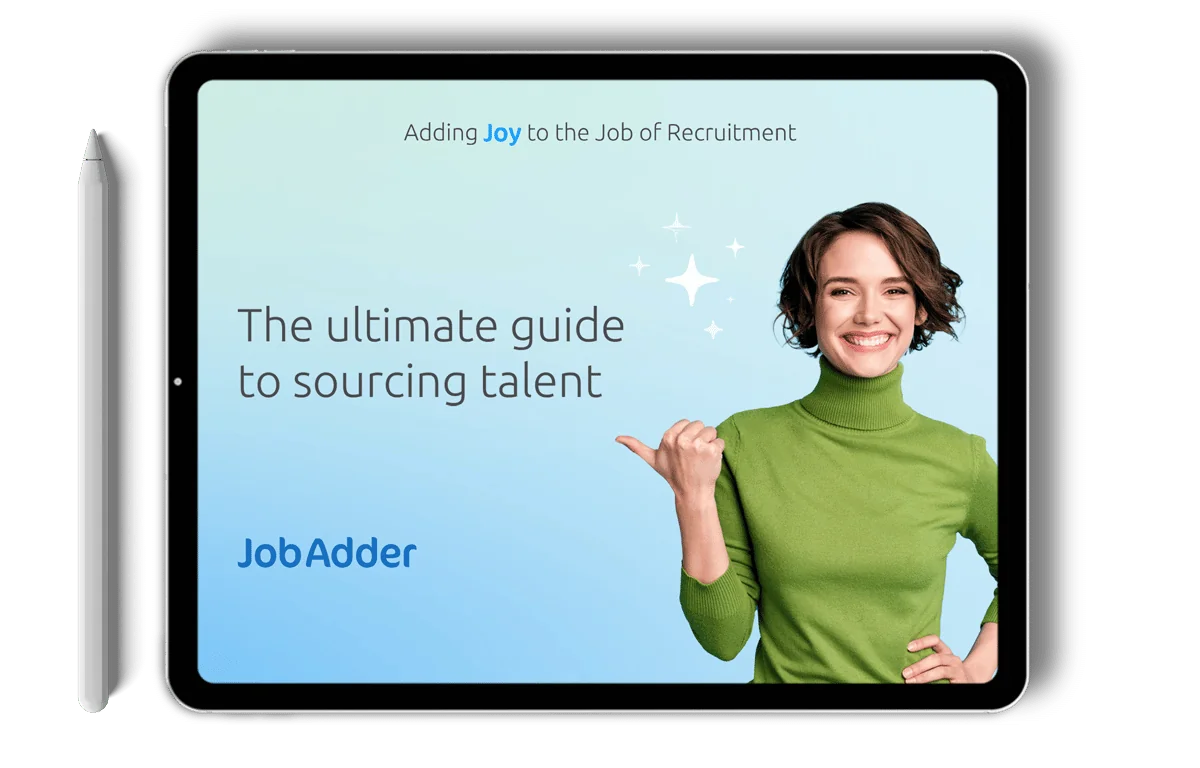Recruitment Blog
How to hire the right person for a new job opening

Finding, interviewing and hiring new employees often takes time and effort. Hiring managers must work hard to find the right fit for a new role out of their applicant pool.
However, making hiring decisions can be nerve-wracking—how can you be sure you’re hiring the right candidate for your open position, especially when you have a large pool of qualified job seekers to choose from.
Below, we explore how you can ensure you find the best candidates for your open positions and take the stress out of the hiring process.
DOWNLOAD OUR FREE EBOOK: The ultimate guide to sourcing talent
12 tips to ensure you’re hiring the right candidate during the hiring process
Before they onboard new employees, hiring managers spend tons of time sorting through job applications and resumes, searching for suitable candidates to interview. Depending on your industry, you may also need to review sample work or portfolios.
It’s clear that a lot goes into the hiring decisions you make. Factors that inform hiring decisions include how candidates answer interview questions, their current skill set and their personality and cultural fit.
But the biggest fear during the interview process is that you’re going to choose the wrong person, they won’t mesh well with the job’s responsibilities and your organisation, and you’ll be back to square one.
To make sure you avoid this, we’ve outlined our 12 tips below to show you how to hire the right person for the job.
1. Understand their career goals and aspirations
During the interview process with a potential candidate, it’s important to gain a high-level understanding of their ultimate goals and aspirations. These questions will help you discover whether their professional aspirations match your open role and business objectives.
These questions will also help you:
- Make better hiring decisions: It’s best to select candidates with long-term goals that match your business objectives.
- Build complete candidate profiles: You learn more about the candidates by gathering information about their training requirements, motives and aspirations.
- Increase job acceptance rates: One way of attracting top talent is by showing you’re interested in their long-term goals and ready to invest in their development.
- Create a talent acquisition strategy: You can identify candidates who are excellent fits for other roles within your business, whether that’s current roles or in the future.
Often, a candidate won’t refer to career goals if they’re not related to the role they’re applying for. So, ask targeted interview questions to determine their goals and how they intend to achieve them.
Remember, careers are not linear. The professional aspirations of your ideal candidate may not seem relevant to their experience or studies at first, but don’t see it as a red flag. Instead, try learning more about their motivation. Often, employees with mixed work and academic backgrounds are standout individuals who are adaptive, curious and risk-takers.
2. Don’t rely on just their resume or CV
The resume is the go-to reference point for most hiring managers during the recruitment and selection process. The usually succinct summary of the candidate’s attributes and qualities is a yardstick for measuring an individual’s fit for your open position.
However, a person’s resume or CV is not always the best way to measure the suitability of the right employee. Focusing too much on resumes is a risky move that may lead to poor hiring decisions, and you’ll miss out on some excellent team members.
Also, consider that not all candidates have the language or soft skills to create an engaging and carefully worded resume. This can cloud your judgment, even when you have a suitable candidate.
Instead, focus on a holistic approach when recruiting and selecting to boost the chances of making the right hire the first time. This approach will save you valuable time and resources. While experience is critical, so is their overall work ethic and commitment, which you often can’t glean from a resume.
One handy tip is to check out their cover letter. Cover letters often provide insight into how a candidate pictures themselves in your company.
3. Collaborate with your team when making hiring decisions
No one person should handle the hiring process—get your entire team involved to avoid unconscious bias and source a range of perspectives.
Collaborative hiring or recruitment is a method that structures the recruitment process to get team members and colleagues to assist in your hiring process. The multi-stage job interview process allows potential employees to meet most of the team they’ll be working with and some other colleagues. This process lets candidates decide if they mesh well with the current team and the company culture.
Collaborative recruitment takes on different forms in each workplace because of differing team dynamic. As you dig into how to hire good people, collaborative recruitment brings several benefits to your process, including:
- Reduces stress on the recruiter
- Improves candidate experience
- Increases business support for the talent acquisition process
- Educates hiring managers on the candidate market
- Cuts down the time for hiring a new employee
- Improves the chances of new hires meshing well with your company culture
- Increases retention rates and improves applicant conversion rates
- Limits unconscious bias that may affect hiring decisions
4. Make sure they’re a good cultural fit for your company
Another excellent indicator of whether you’re hiring the right person is determining if they’re a good cultural fit for your business. Are they passionate about the same things? What drives their work ethic?
Every business boasts its own unique identity and culture. Employees who don’t embody the company culture can harm workplace morale and productivity.
One way of assessing cultural fit and work ethic is by asking the right questions during the interview. Unfortunately, most potential employees already know what you’re looking for. Therefore, they draft answers to fit your questions and get the position—even if they’re not the best fit.
Prevent this from happening by asking out-of-the-box questions. While difficult to implement, here are a few ideas to help you come up with interview questions:
- Ask the interviewee how they would deal with situations specific to your business
- Ask unorthodox questions such as what the interviewee finds most appealing about working in your company
- Have the interviewee clarify their professional goals and values
These questions will help gauge the candidate’s perception of your work environment and current employees. Make sure the questions are not discriminatory.
5. Pay attention to the questions they ask during an interview
Hiring managers and talent acquisition professionals can also tell if a candidate is a good fit by evaluating the questions they ask during an interview. The right candidate should ask thoughtful questions during the interview.
These questions show the candidate’s engagement and preparedness. View the job interview process as a dialogue, rather than a question-and-answer session.
The right person for a new job opening cares about:
- The team they’ll be working with
- The management team
- How their input helps your business move forward
Take mental notes of the questions candidates are asking. Watch out for questions such as “When do we get paid?” “What are your working hours?” and “What are our off hours?” These questions show the candidate is most interested in the paycheck and not the big picture.
6. Get out of the office
Interviews can feel staged, and candidates are likely to be prepared for that. If you want to evaluate their interpersonal skills, take them outside of the meeting room.
For example, take the candidate out for a coffee break or lunch. A visit to a restaurant or cafe will reveal many clues about the individual.
Watch how considerate the candidate is to others, such as how polite they are to servers and others and whether the candidate gets flustered or irritated by issues.
Taking a candidate outside the work environment also helps your interview to stand out in your candidate’s mind if they’re interviewing for multiple roles at once.
7. Be clear about job expectations and responsibilities in the job description
Reading a job description often informs a candidate’s first impression of the role they’re applying for, so you want to ensure transparency about the job expectations and responsibilities. Having a well-written and comprehensive job description will attract qualified candidates who see themselves in the role.
When done correctly, job descriptions can do wonders for the recruitment process. However, make sure the description aligns with your business’ overall goals.
Once the candidate starts, they’ll probably go through a probationary period, so job descriptions can help your management team determine critical Key Performance Indicators (KPIs) for job evaluations.
A well-crafted job description also helps protect employers and employees against legal risk by ensuring their expectations are aligned.
8. Conduct thorough reference checks or background screening
Consider carrying out thorough reference checks (especially for higher-level positions) and utilise an automated background screening tool (we integrate with heaps of tools that offer easy background and reference checks!). These checks are a critical part of learning how to hire the right person every time by doing your due diligence.
The best way to find out how someone acts in the workplace is to talk to their previous managers and co-workers. These sources can provide extra information on the work ethic, personal skills and qualifications that a candidate may not add to their resume.
9. Use an Applicant Tracking System
Finding the right candidate starts with your pool of applicants. Finding the perfect fit is unlikely if you can’t attract qualified candidates to your job postings.
Fortunately, an Applicant Tracking System (ATS) can automate your hiring process. An ATS is a centralised database for all information regarding sourcing and tracking your candidates, allowing you to organise and analyse many applicants at once.
An ATS is with you from the moment a candidate applies to their first day in your company, automating scanning resumes, communications, scheduling interviews and a whole bunch of other manual admin.
An ATS will also allow you to store data on applicants, utilise AI and skill matching to discover candidates already in your talent pool, optimise hiring data and referrals, and much more.
10. Ask for referrals from your current employees
We already discussed how reference checks are important when hiring the right candidate, but they can be unreliable at times. One way to ensure you’re getting quality candidates is to ask for candidate referrals from your current employees.
Employee referrals can help your business find qualified individuals to fill up a vacant position. The strategy works by asking your existing employees to recommend candidates from their network they think are a good fit for the job. These are potential employees who may not have seen the job openings for your company.
The employee referral program can benefit your business in several ways, including:
- Reducing recruiting costs by saving you the money you’d spend on pre-screening, job board fees and more
- Increasing the quality of new hires because current employees will probably recommend people they feel are highly qualified for the role and fit in with your company culture
- Faster onboarding because the referred new hires already know someone in your company
- Expediting the hiring process by skipping the preliminary recruitment process steps such as resume screening
- Improving retention because your current employees will refer candidates who want to work for you and remain at your business
11. Ask the right interview questions
Asking the right interview questions is also key to finding the right candidate. While it’s okay to ask generic questions like, “What do you know about our company?” and “Why are you the best candidate for the position?” you should aim to dig deeper than that.
Prepare thoroughly for the interview. You should ask questions to help you determine the candidate’s interest in your company and job. The questions should also enlighten you about their career plans and work history. Remember to ask questions that will shed light on their work habits and values and reveal their weaknesses, strengths, skills and knowledge.
Of course, the primary goal of the interview is to see if they are a good fit for the company culture too. Asking behavioural questions such as, “What is an example of a workplace challenge you’ve faced?” provides much more value and insight to the conversation.
You also need to include other interview questions to help you dig deeper, such as open-ended and close-ended interview questions. Once you establish a baseline of who the candidate is and why they want to work for you, get to know their work ethic and what type of work environment they thrive in.
12. Trust your instincts
Last on this list of hiring tips is your gut. An important part of being a hiring manager or recruiter is being confident in your decisions and trusting your instincts. If you have doubts about an applicant, find the “why.”
Everything might seem alright on the surface, but you have doubts. Don’t ignore them. The nagging suspicion you get during the interview about a candidate’s attitude will magnify after they’re on the payroll.
Find the right candidate for your open jobs with JobAdder
The hiring process takes up a lot of time and effort, but there’s a way to streamline your efforts to save time and fill roles quickly.
JobAdder’s Applicant Tracking System (ATS) can help streamline your recruitment process, from candidate sourcing to talent pooling, skill matching, communications, interview scheduling, background checking and much more.
Find out more about how the JobAdder ATS can help hiring managers save time and money with a more efficient hiring process by signing up for a free demo now.
Need help building your talent pool? Download our ultimate guide to sourcing talent.

Related blog posts

To excel in the competition for top talent, proactive workforce planning is essential. Traditional methods struggle to adapt to evolving …
Ready to get started?
Talk to one of our friendly team members


